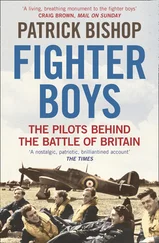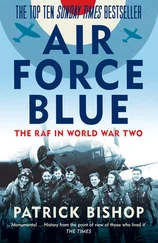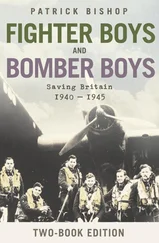For all the danger, operations involved little that could be described as exciting or could later be interpreted as glamorous. There were stretches of tedium. For wireless operators and bombaimers there was little to do for much of the time. Only the navigator and the pilot were kept permanently occupied and there was not much fun in flying bombers. Piloting a Lancaster was nothing like skidding across the skies in a Spitfire. It was a task rather than a pleasure, requiring endless tiny adjustments and constant vigilance. Guy Gibson, the leader of the Dams Raid, compared bomber pilots to bus-drivers.
There was a complete absence of comfort. The rear gunner, stuck at the ‘arse end’ of a Lancaster, froze. The wireless operator, stuck next to the port inner engine, often roasted. Everyone was swaddled in multiple layers of clothing surmounted by parachute harness and Mae West lifejacket. It was hard work moving around the cramped, equipment-stacked interior, where every edge was sharp and threatened injury.
On the ground life was far removed from the ease of the RAF’s pre-war existence and there were few of the comforts or entertainments available to the fighter pilots of 1940 when they touched down at the end of the day. Writing to his wife from his first squadron, Flying Officer Reg Fayers was anxious to dispel any idea that the organization he had joined resembled ‘Max Aitken’s RAF’. Aitken, Lord Beaverbrook’s son, had fought in the Battle of Britain and was a model of style and sophistication. ‘You are fastidious and sweetsmelling cleanliness,’ Fayers declared. ‘You are gentle, you are comfort … the RAF is opposite in all respects.’ 12
The defining sound of Bomber Command life was not the cheerful blare of the mess gramophone but the patter of rain on a Nissen hut roof. The pervading smell was not the whiff of expensive scent but the reek of coke from a smoky stove. Opening the doors of their quarters the crews looked out not at the green, upholstered Sussex hills or the fertile fields of the Weald but the vast skies and watery steppes of Lincolnshire.
Fighter pilots went to the pub by car. Bomber Boys travelled by bike or bus. They drank flat, weak beer in drab pubs and dance-halls where they competed for the favours of young women war-workers. Sex was in the air but when it took place it was often urgent and utilitarian. What they really wanted was love and it flared up often, as fierce and incandescent as the pyrotechnics that marked the targets they bombed. Sometimes it was just as ephemeral.
But once on ‘ops’, the world of lovers, friends and families beyond the base dwindled and faded, to be replaced by a different reality. The future stretched no further than the next few hours. Life was reversed. Night became day and day became night, the time when the crews went to work. Then, to each crew member the only people who mattered were those around him. There were only seven people in existence and the universe had shrunk to the size of a bomber plane.
On the morning of Sunday 3 September 1939, at bases all over Britain, ground and air crews stood by for the announcement that after many false alarms they were finally to be launched into battle. At Scampton, ‘Sunny Scampton’ as it was wryly nicknamed on account of the usually dismal Lincolnshire weather, the men of ‘A’ Flight, 89 Squadron, were smoking and chatting in the flight commander’s office while they waited for the prime minister to speak on the radio. At 11 a.m. the talking stopped and the room filled with the low, apprehensive voice of Neville Chamberlain telling them that, as of that moment, a state of war existed between Britain and Germany.
Until then, the flight commander, Anthony Bridgman, had been a study in unconcern. Now he took his feet from his desk, exhaled a slow stream of cigarette smoke and spoke, ‘quietly and rather strangely’ according to one who was present, to his men. ‘Well boys, this is it,’ he said. ‘You had better all pop out and test your aeroplanes … there will probably be a job for you to do.’
There was. In the early afternoon they were called to the lecture room where the squadron’s CO, Leonard Snaith, a distinguished pilot whose gentle manner set him apart from the boisterous, public-school ethos of the pre-war RAF, announced ‘we are off on a raid’. The targets were German pocket battleships, believed to be lying in Wilhelmshaven harbour, the great heart-shaped North Sea inlet. Their orders were to bomb them. If the ships could not be found, they were allowed to attack an ammunition depot on the land. The six crews detailed to the task were warned that ‘on no account’ were they to hit civilian establishments, either houses or dockyards, and that ‘serious repercussions’ would follow if they did so.
They surged to the crew room to climb into their kit and wait for a lorry to take them to the aircraft. They were flying in Hampdens, up-to-date, twin-engined monoplane medium bombers with a good range and a respectable bomb-carrying capacity. They had a bulbous but narrow front fuselage, only three feet wide, and a slender tail that gave them an odd, insect look. It was cramped for the four men inside, but the speed and handling made up for it.
Before they could leave, news came through that the initial take-off time of 15.30 had been put back. The men lay outside on the grass, smoking and thinking about what lay ahead. Another message arrived saying there had been a further delay, provoking a chorus of swearing. By now everyone’s nerves were fizzing. One pilot, despite a reputation for cockiness, found his ‘hands were shaking so much that I could not hold them still. All the time we wanted to rush off to the lavatory. Most of us went four times an hour.’
At last the time came to board the lorry and just after 6 p.m. the engines rumbled into life and the Hampdens bumped down the runway. For all their training, few of the pilots had ever taken off with a full bomb load before. The aircraft felt very heavy with the 2,000 pounds of extra weight but they lumbered into the air without mishap and set course over the soaring towers of Lincoln cathedral, over the broad fields and glinting fens and rivers of Lincolnshire, and out across the corrugated eternity of the North Sea for Germany.
As they approached Wilhelmshaven, the weather went from poor to atrocious. The gap between the grey waves and the wet cloud narrowed from 300 to 100 feet. Gun flashes could be seen through the murk but there was no telling where they came from.
Eventually, Squadron Leader Snaith’s aircraft swung away to the left. The appalling conditions and the impossibility of knowing precisely where they were had persuaded him there was no point in carrying on. The initial disappointment of one pilot gave way to the realization that Snaith was right. ‘For all we knew,’ he wrote, ‘we were miles off our course. The gun flashes ahead might have been the Dutch Islands or they might have been Heligoland.’
They dumped their bombs into the sea and headed for home. By the time they crossed the coast at Boston it was dark. Most of the crews had little experience of night flying and one got hopelessly lost. Luckily, the moon picked up a landmark canal and they followed it back to Scampton, landing tired, and rather disillusioned, at 10.30 p.m. ‘What an abortive show!’ wrote the captain of the errant aircraft. ‘What a complete mess-up! For all the danger we went through it couldn’t be called a raid, but nevertheless we went through all the feelings.’ 1
But at least everyone had got back alive. If Bomber Command’s first offensive operation was a disappointment, the second was a disaster. On 4 September more attacks were launched against German warships off Wilhelmshaven and further north, at Brunsbüttel, in the mouth of the Kiel Canal. A force of fourteen Wellingtons and fifteen Blenheims set off. The weather was dreadful. Ten aircraft failed to find the target. The Blenheims managed to reach the pocket battleship Admiral Scheer and the cruiser Emden at Wilhelmshaven. They even landed three bombs on the Scheer . The bombs failed to explode. The Emden was damaged when a stricken bomber crashed on to it. But five of the attacking aircraft were destroyed, most by flak from the fleet’s anti-aircraft guns.
Читать дальше












